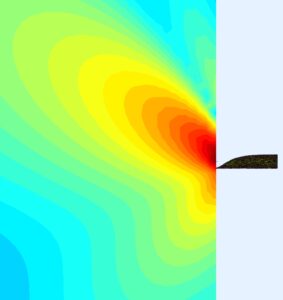In the first article about the original Kalrson tube, I was able to develop the BEM models and investigate the acoustic properties of this special type of horn/waveguide. I made no secret of the fact that I particularly disliked the directivity control. A few days ago, I had an exciting idea about how to modify the Karlson tube to achieve better results. The implementation wasn’t that complicated, and in the end I was quite surprised at how good the results were.
Tag Archives: Karlson
The Mysterious World of the Karlson Tube
I have been interested in Karlson speakers for quite some time. I find their use as Karlson tubes in combination with compression drivers particularly exciting, even though the applications I’ve found on the web seem mysterious, and make me wonder how they actually work technically.
It is well known that a native tube with a length of 1/4 of the desired cut-off wave length, open at one end, exhibits a strong fundamental resonance plus higher odd harmonics. To show this as reference, I have created a BEM model for a 25cm native tube with a 1.4in driver membrane which gives the tube’s radiation impedance:
I had to increase the scale as otherwise the peaks were cut away. Following the Karlson theory, if a slot is added to the tube, ideally opening exponentially over its length, the strong resonance of the native tube should be largely smoothed out, resulting in broadband radiation. The slot itself should extend over at least 2/3 of the length of the tube.
For the BEM simulation, I first had to consider how to simulate such a slot in the tube. After some attempts, I ended up obtained meaningful results with the following model when the interface represents the cut-out surface. In other words, the tube with slot and the interface together form the complete initial tube without slot.
For the exterior domain, the driver, and tube mesh files could be re-used with lower resolution. The cut-off frequency was set to 525 Hz and T=1.
Be aware of the changed scale, the resonances are greatly reduced. Very interesting results! We can now further reduce the length of the tube by fixing the cut-off frequency.
All models used constant velocity drive, so the radiation impedances look fine with respect to acoustic loading. Even the shortest tube has good acoustic loading down to 2k Hz. This opens up new possibilities for variation in terms of cut-off frequency and tube length if you want to adapt and optimize the design for your own purposes. And not just only for compression drivers, but also for subwoofers, if necessary.
An exciting question was if the cut-off impedance peak could be further smoothed by preserving the length of the tube. As my current calculator has the length of the tube fixed as input parameter is a bit counterintuitive but by settings T=0 the start slot width becomes wider:
The resulting radiation impedance is indeed more smoothed, with a lower peak at cut-off:
At least for me these results are quite surprising as I would not have expected that such a large start slot width is still working reasonable well.
In many pictures that can be found on the web showing applications using a Karlson tube, it is noticeable that many setups angle the Karlson tube either upwards or downwards. This already suggests that the sound propagation is not centered on the axis of the tube, but is somehow angled. And here is the justification showing the BEM fields:
I have not measured the angle exactly, but it seems to be around 30-40 degrees in this case. Despite the interesting results, it should be noted that these are devices that strongly beam at high frequencies:
For me personally, studying Karlson tubes was very worthwhile, as I was able to develop the skills to simulate this design with BEM and then adapt the model for other applications based on the idea of this design.













